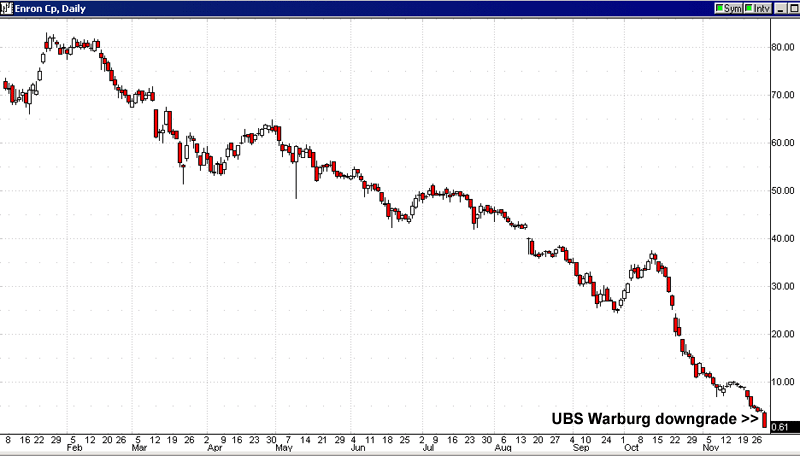| Solar X-rays: Geomagnetic Field: |
From n3kl.org
| Solar X-rays: Geomagnetic Field: |
On this site I show some interesting (to me at least) scientific charts and images. Some I've created and others are from other sources. Years ago I used to research in the solar and planetary fields. I still have an interest in the field. Also some studies of the bubbles in stocks and Gold, my simple epidemiology analysis of SARS, and a few other odd charts.
So first, here are recent Solar X-Ray charts from GOES (sec.noaa.gov). Someday I will re-arrange the site into smaller pages. This "blog" started small and grew. :)
June 5, 07, After a long quiet period with levels barely making a reading, we had a string of flares with one X class flare.


December 19, 06, The month's string of X-class Solar flares continues with two more: Dec 13-th (X34), 14-th (X15). The first chart shows the three day period followed by two zoom-in charts.

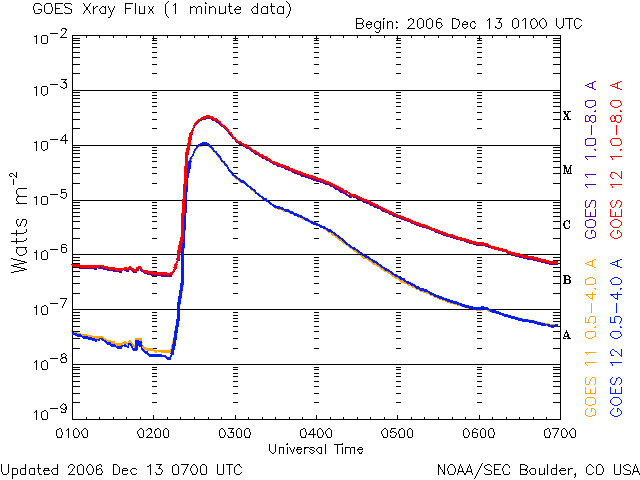
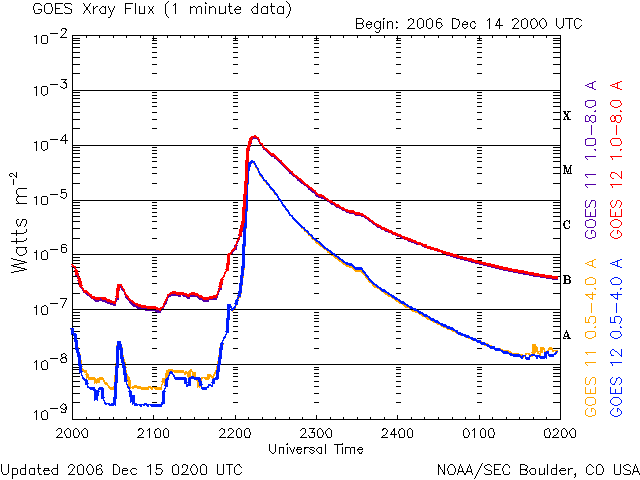
December 10, 06, The new Solar cycle is getting started with a bang, two large X clas flares, very unusual at a Solar Minimum. First on the eastern limb of the sun, December 5, an X90 flare followed the next day by an X64. There were also a number of smaller M-class flares. First a summary chart and then two detailed charts.



There were several M flares in early 2006 including this M82 on April 27, 06.

October 22, 06,Here is a "better late than ever" review of the Solar Flares in 2005 as the Solar Cycle finishes. These are posted here since the originals have disappeared from the GOES web site. There were 12 charts since the last update in Feb, '05. These are shown in chronological order, unlike the earlier charts posted near in real time (below).
February 19, 05, an M4.0 flare.

May 13 and 15, 05 M84 and M36 flares.

June 16, 05, M40 flare.
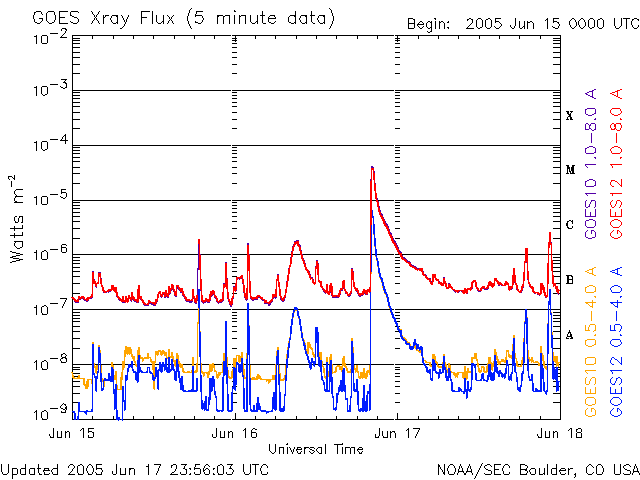
July 7 and 9, 05, M51 and M30 flares.
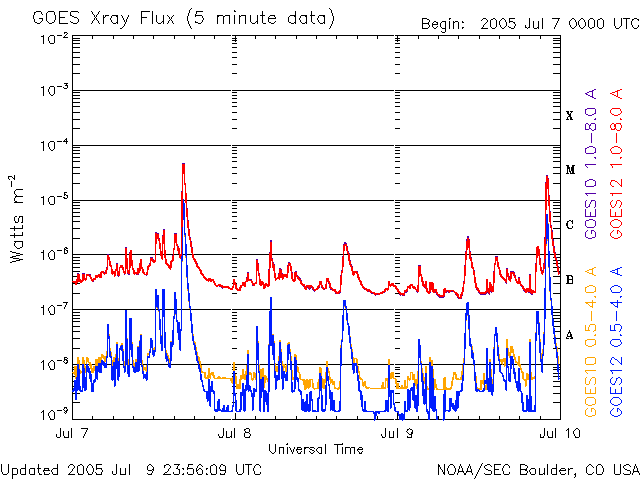
July 13 and 14, 05, an M34, M55, X14 flares.
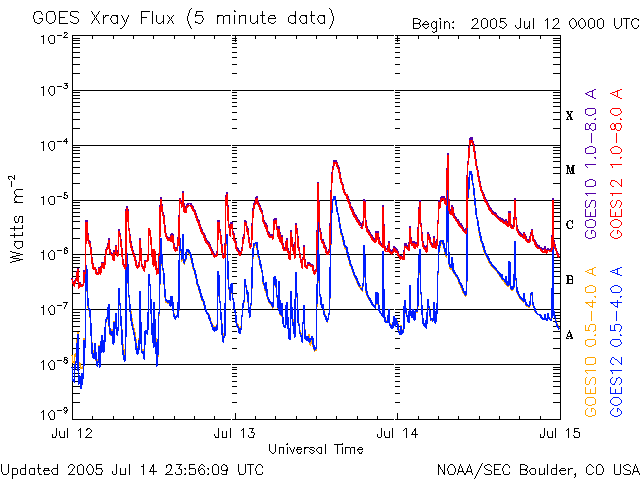
July 30, 05, an M49, X13 flares.
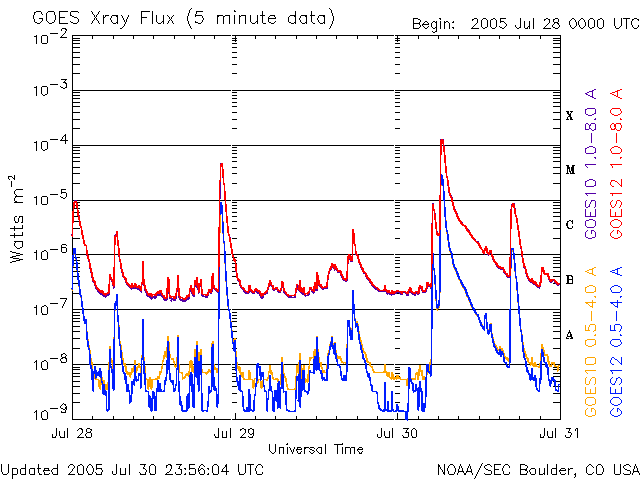
August 2-(3), 05, an M43, (M35) flares.
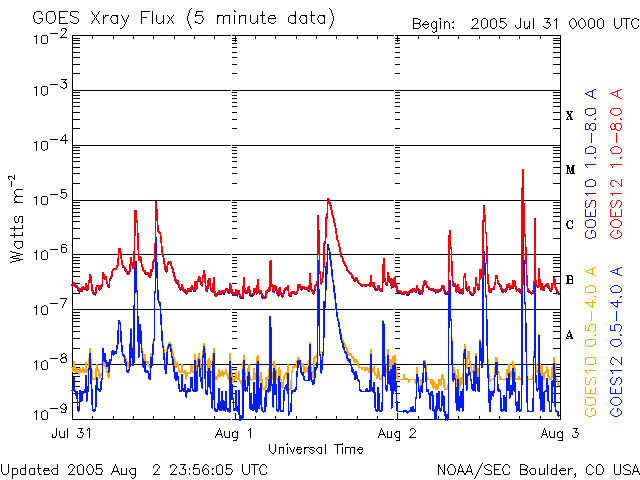
August 22-23, (25), 05, M28, M62, M29, (M66) flares.
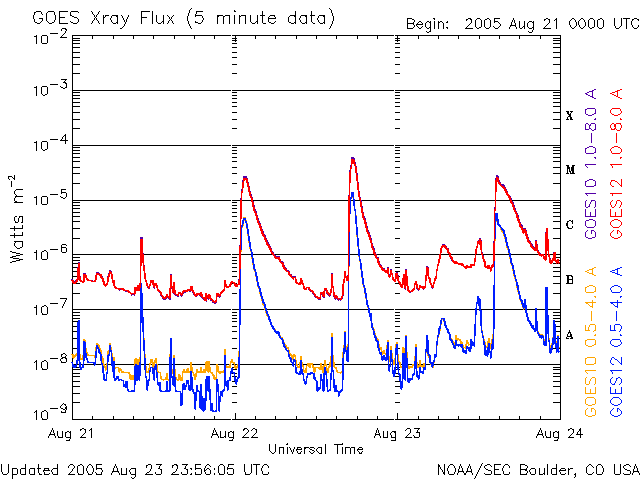
September 8, 05, an X180 and X57 flares.

September 9 and 10, 05, X38, X65, X22 flares.

September 12-14, 05, M60, M15, M14, X15, X15, X19, M45 flares.
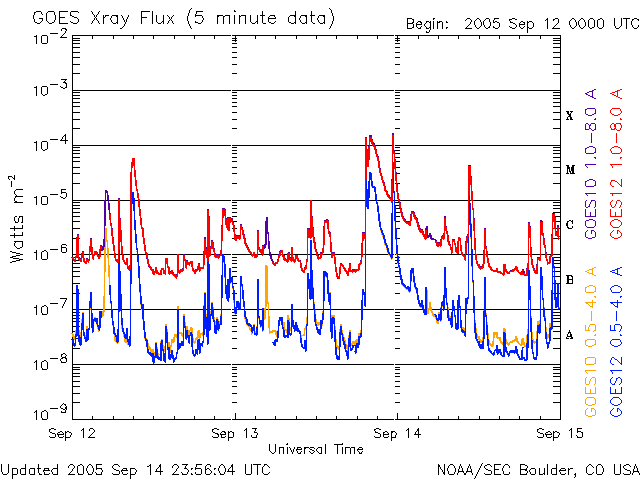
September 15-17, 05, X11, M48, M38, M98 flares.

November 13-15, 05, several M flares.
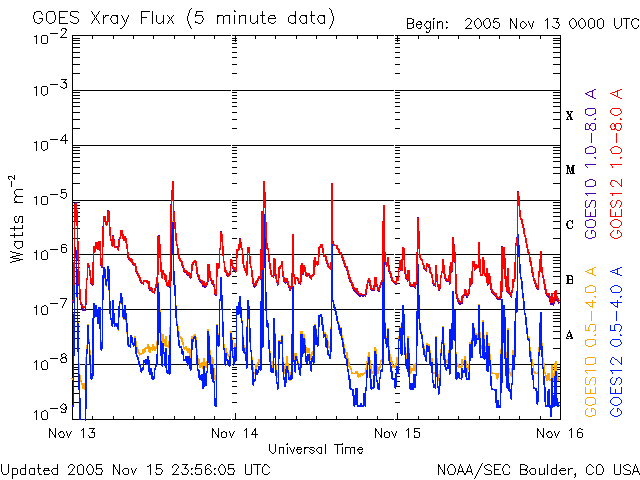
December 2, 05, M68, M80 flares.

October 12, 06, It has been a while since I updated this site. A review of 2005 Solar flares will be posted soon. Also I note there are several broken links needing either tossing or fixing. As soon as I learn to spell procastinate (to postpone or delay needlessly), I'll work on have to work on concrastinate (the opposite?).
February 5, 05, Wondering what of the active region that produced the last X flares? Its glow over the Solar horizon is already visible in the Solar UV images. This from spaceweather.com.
SOLAR REPORT: Giant sunspot 720 is about to return. If predictions are correct, it will peek over the sun's eastern limb on February 6th, then slowly turn to face Earth by February 13th. Solar activity should increase during this time.
January 20, 05, An X7.1 flare makes the biggest of the 6 X-class flares so far this year!. The large Sunspot is moving off the Solar limb so the show is about over. Another CME was visible after this flare, although not aimed at Earth. Yesterday's X1.5 flare is a yawner by comparison. :-)
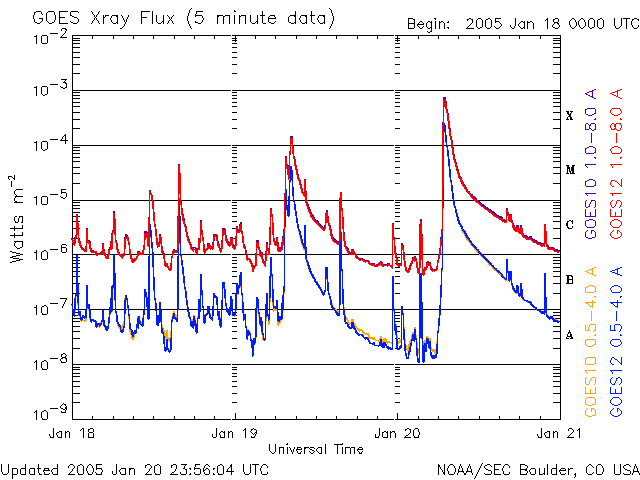
January 17, 05, That X3.8 flare makes about 4 X-class flares so far this year!. The large Sunspot is moving toward the Solar limb so the show should be over soon. Another large CME is also visible after this last flare, although not aimed at Earth like yesterday's.
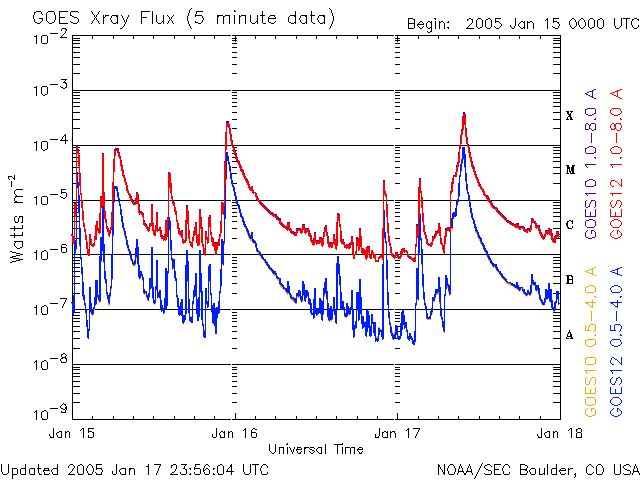
January 16, 05, The year has been kicked off with a series of large Solar flares, including an X2.8 class flare today, all in the large Sunspot just above dead center. A large CME is also visible around the Sun as it approaches Earth like a Klingon weapon blast.

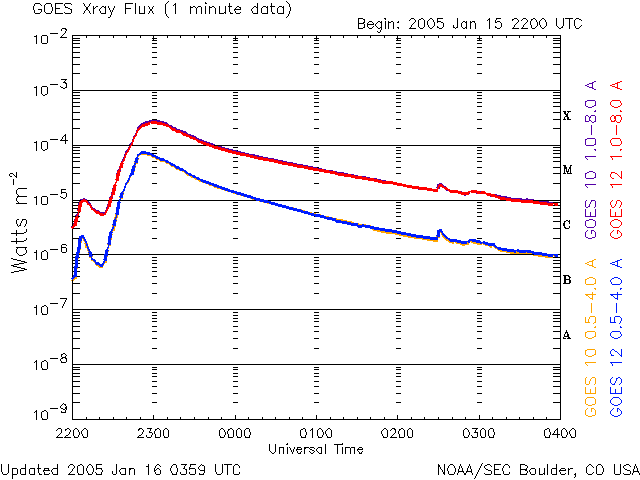
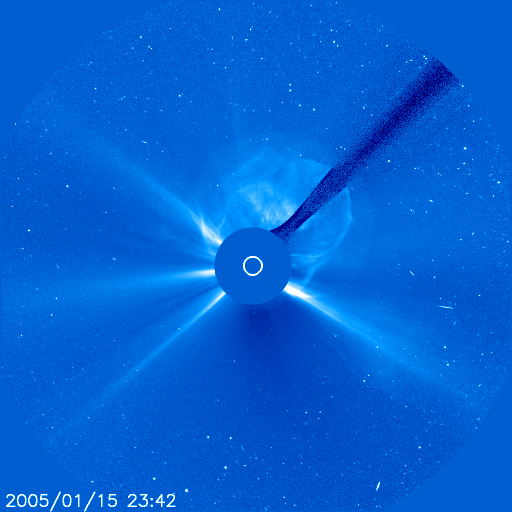
January 1, 05, Happy New Year, an X1.8 class flare today, as an active sunspot moves around to the front.
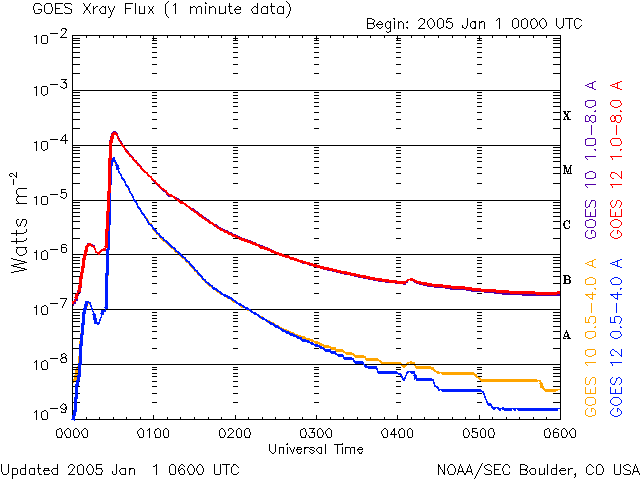
November 7, 04, An X2.2 class flare today, as activity picked up after a few months of quiet solar activity. On November 6th there was an M9.8, nearly an X class flare.

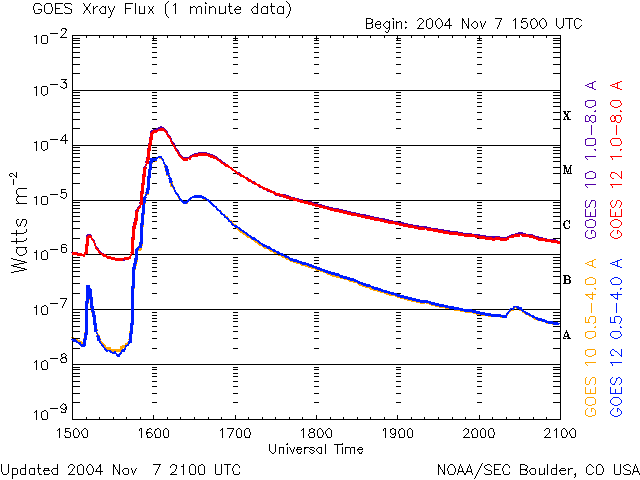
July 17, 04, Yet another X class flare today, an X1.1. That is 6 X-class flares in 3 days.
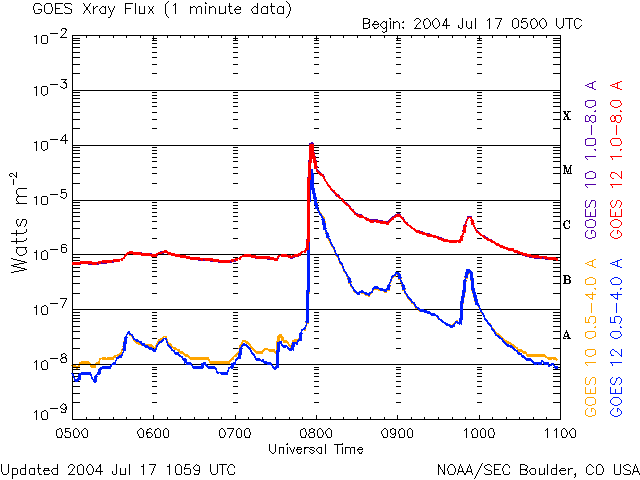
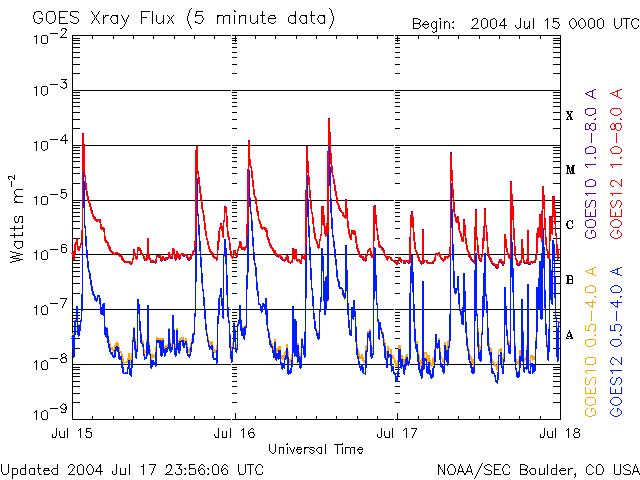
July 16, 04 (afternoon), Oops, it's three more X flares today. To the X1.4 add an X1.1 and X3.8!!! These are coming from region 649 that just came around the Sun's limb. So this might continue for a few more days.
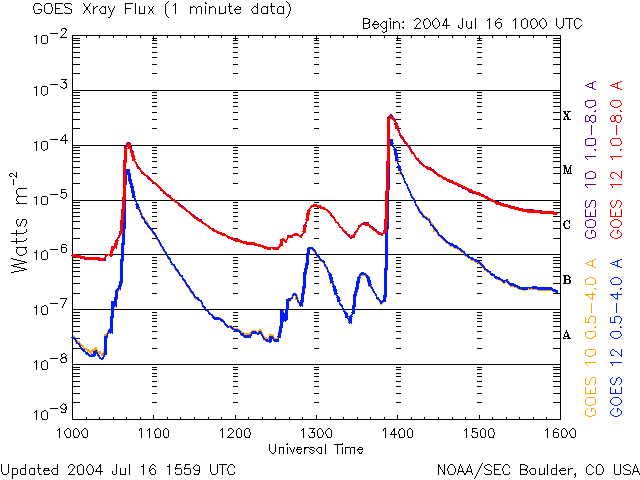
July 16, 04, Whoa-ha-ha! and a third flare, X1.4!!

July 15, 04, Whoa-ha! And another flare, X1.7!!
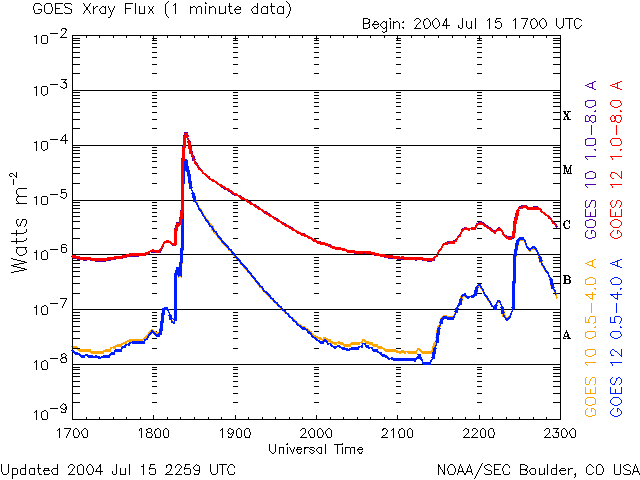
July 14, 04, Solar activity has returned with a bang! an X-class X1.9 flare that is.
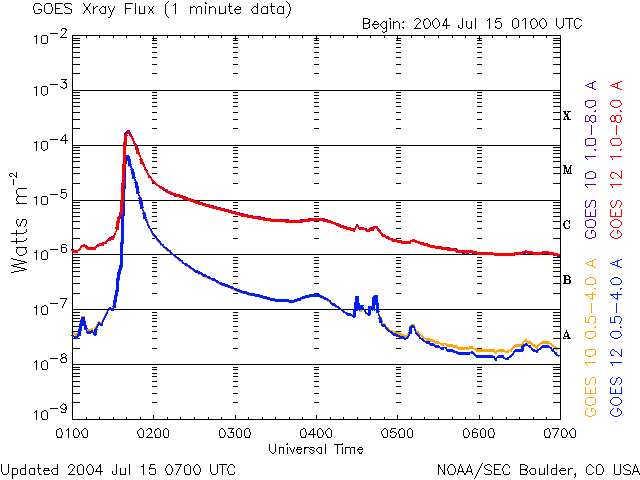
July 13, 04, Solar activity has returned as several sunspots arrive on our side of the Sun. There have been about half dozen large M-Class flares. Interesting aside, Gold prices have just popped above $400/oz.
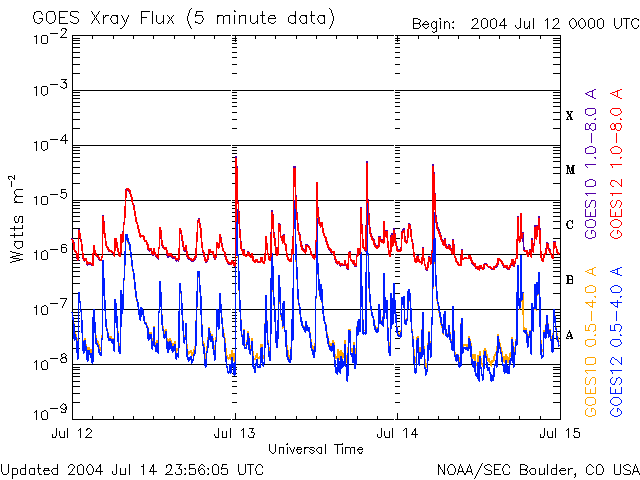
June 5, 04, The market is going nowhere, ditto for Gold and even the Sun is quiet. Venus is moving into transit of the Sun and this will be interesting to see. I'll be looking at photos taken by others in Europe since the time of transit does not favor the U.S. observers. But there is also nearly live imaging from SOHO that will be interesting. Since SOHO is near a libration point and therefore a bit more distant from Earth than the Moon, this will represent a nice alternative view.

The bright object on the left is Venus with a horizontal line resulting from near by pixel overloading. In the center is the blocked image of the Sun (so plasma blasts from flares are visible). A few days from now, Venus will also be blocked and we'll switch to another image.
On the Linux scene. In my quest to break free from Microsoft Lock In, I've been checking out Linux since last November. After using Knoppix 3.3, Mandrake 9.2, Mepis, and Lindows/Linspire, and SuSE, I've settled on PCLinuxOS for 99.95% of my computing.
Since I have two removable hard disks, I can swap out my main system for a look at an alternate system. It takes only about 5 minutes to change systems. A secondary drive holds a copy of my working user data files which are kept up to date with what ever Linux system is in the main drive. I can also boot up a Live CD and access the secondary drive, which I've done for several days at a time. Presently I have SuSE 9.0 installed on one hard disk and PCLinuxOS on the other. My PCLinuxOS uptime is now 8 days plus since I switched out the SuSE hard disk. Before SuSE, I tried Linspire for a week or so (its problem for me: too much like Windows!).
For hard disk installation, my top Linux choices are: 1) PCLinuxOS, 2) SuSE, 3) Mepis, and 4) Linspire. And for Live CD: 1) Knoppix 3.4, 2) PCLinuxOS, 3) Mepis. 4) LindowsLive 4.5, and 5) SuSE LiveEval.
Rebooting Linux just isn't needed with uptimes being broken only be power failures (a once a year or less event) or perhaps booting up to satisfy curiousity about the latest just announced Linux distro. Most Linux distros provide all the day to day products I need for personal use: Mozilla (web browsing and yahoo email), OpenOffice (Word and Excel equivalents), Acrobat, GIMP (image editing), and many more.
May 11, 04, The Sun is quiet and the market is boring. However, on March 21 I captured a 1.6MB movie of Comet Bradford passing close to the Sun, as seen at sohowww.nascom.nasa.gov/.
I'm experimenting with three Linux distros lately on a new AMD computer: PCLinuxOS, SuSE, and Linspire (after a few months running Mandrake 9.2 and Mepis on an E-Machine, good-bye E-Machine). I ended up using KNOPPIX live CD for about a solid month before I could get Windows data recovered and re-installed. The live CD ran without any problem, no reboots, no crashes! Remember, friends don't let friends drive Windows. :-) LOL. And for the geeks reading this, I'd like to point to Langalist.com for good ideas for computing if you must use Windows. ...
Dec 16, Gold chart update. If I could update the chart to January, one would see the price is following the model very well. My main (Windows)computer's HD is broken. So I'm working off KNOPPIX 3.3, a bootable CD Linux system that runs with part of RAM reserved for its system "disk". I got the CD in a book called Moving to Linux - Kiss the Blue Screen of Death Goodbye! by Marcel Gagné
Jan 7 Update. After a quiet December, four M Class X-ray flares in three days.
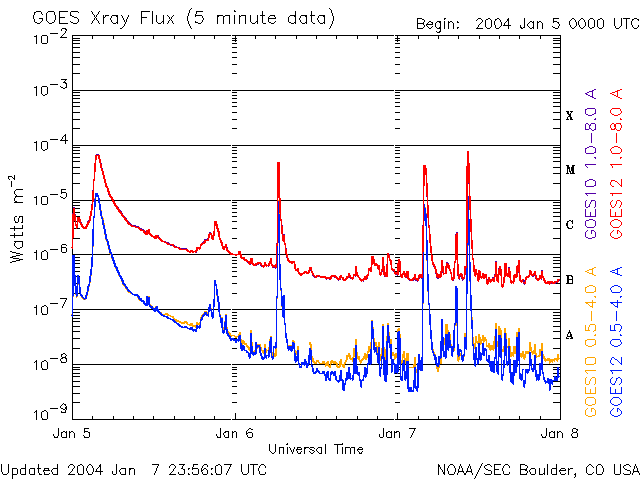
Nov 20 Update. see that bright spot in the second 195 Å image? Yup, just fired off an M9.6 flare, almost X-Class. This flare has caused another geomagnetic storm raising the Kp index. Ooops, another M Class, M6.1 at 2350 UT as the Kp index pegs at 9.

Nov 19, Update. Region 501 draws a bead on us, emitting a small M Class flare. Look at what this region can put out (below on Nov 9th when it was a side view and missing us). New regions are showing up on the left, so here we go again. Time to dust of your lead sombrero. :-)

Nov 13, Update. A special day, the eye of the storm so to speak. The next active region is just appearing no the left while the last active region is disappearing on the right. A look at the LASCO C2 300k mpg movie show repeated CMEs resulting from activie regions on the Sun's far side. Meanwhile, on our side there is almost nothing going on. Enjoy the quiet! :-)

Nov 10, Update. My market Crash Watch is updated below. Meanwhile on the Sun, all three active regions are on the far side now, having left on the right side limb. But they are still kicking out CMEs every few days. So watch for the fireworks to return later this week. Look at that flame on the left, here them come.... then scroll down to see images of the most extrodinary month of Solar flares.
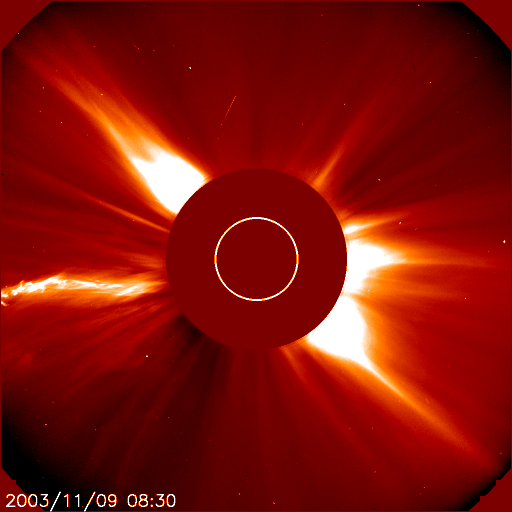
Check out my Mega Flares of October 2003 page which recalls the amazing images of mega and monster flares that I tracked right here (from sources at NASA, NOAA and SOHO) on this page every day.
And check out my earlier solar activity watch images when I thought it was getting interesting. If only I had known... :-)
The Crash Watch
Sep 5 It is being called an 'echo bubble' by Steve Milunovich, Merrill Lynch & Co.'s chief technology strategist, now that it is about to burst again. So did Paul Krugman back on June 26.
In short, the current surge in stocks looks like another bubble, one that will eventually burst. - Paul Krugman. Jun. 26, 2003
But I wouldn't argue with it being a "bubblet." - Paul Erdman. July 3, 2003
But back on June 17, I emailed friends that I thought I saw the first hints of what looked to me like another bubble. Then on July 3, I started posting here charts of that bubble behavior (see below) computed by data fits to Didier Sornette's formula log-periodic formula, log-periodic power law (LPPL).
After several strong months, the NASDAQ looked, IMO, to be starting a small scale Sornette bubble blow-off. The price curve (black) is on track with the prediction curve (red). The red curve is the Sornette bubble model. Once the log-periodic signature is noted, a major correction/crash is possible at any time. The July 3 calculation indicated the next cycle would get into the 1700s, which did occur.
Read my earliest notes on this NASDAQ Mini-Bubble of 2003 where I used a shorter time interval for fitting the bubble, starting in March.
More rescently, the NASDAQ may have been seeing a classic Sornette bubble blow-off here (in Sept-Oct 2003). The model curves go infinite in mid-September or maybe late October. We expect something to give before then. Then watchout below!
Nov 14, Update. You know if the solution seems to be slipping away like in earlier charts, something just might be wrong. So I forced a restart of the solution attempting to find a better local minimum in the lumpy solution space. And I find that we may just be at the critical time right now!! This is consistent with a note that there is a rapidly shortening cycle observably in the last few months with a period cutting by a factor of about two on each cycle.
For you fractal fans, the frequency, ω is related to the cycle to cycle self-similularity ratio, L, by the formula
L = e±2*π/ω
so in the current echo bubble we have ω = 9.0 so that L
= 0.50 (bubble) 2.00
(anti-bubble). Since we are in the bubble phase of this echo bubble, we
see each cycle is about half as long as the preceding.
Check it out, looks like a critical point without a blow off. This suggests a correction not a crash. The key parameter, alpha, is near unity also suggesting no crash. Let's hope!
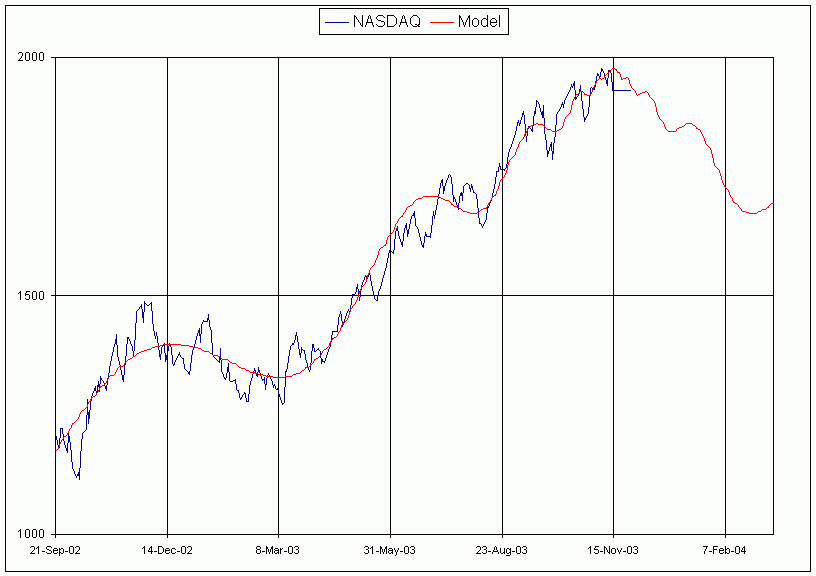
This chart shows data through Nov 24 where the critical time looks like Nov 5.
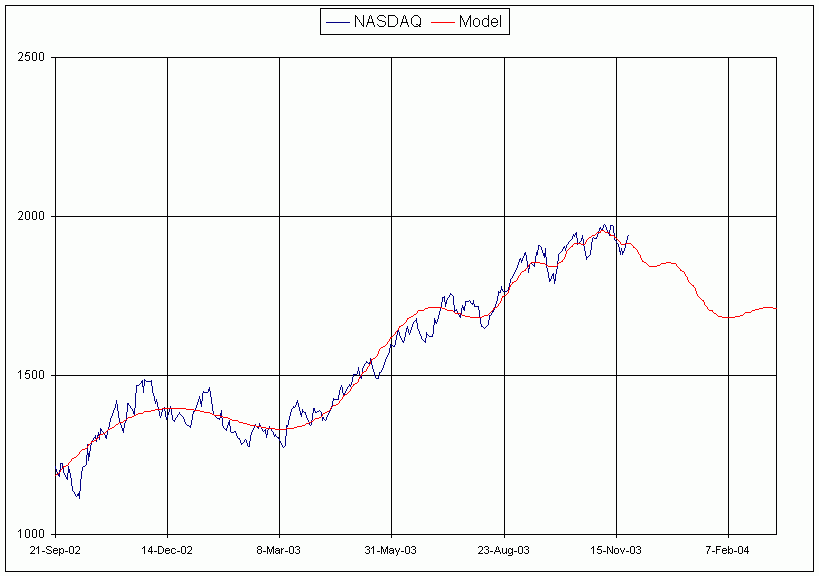
Where will it all end? My friend, Vernor Vinge (futurist, sci-fi author, and mathematician) called it a Singularity when he wrote of the possible unstable end of humanity at the hands of out of control technology.
Dec 1, Gold. Is gold making a run or what? Closed above $400.

Dec 16, Gold update. Seems to be following the path in the above chart.
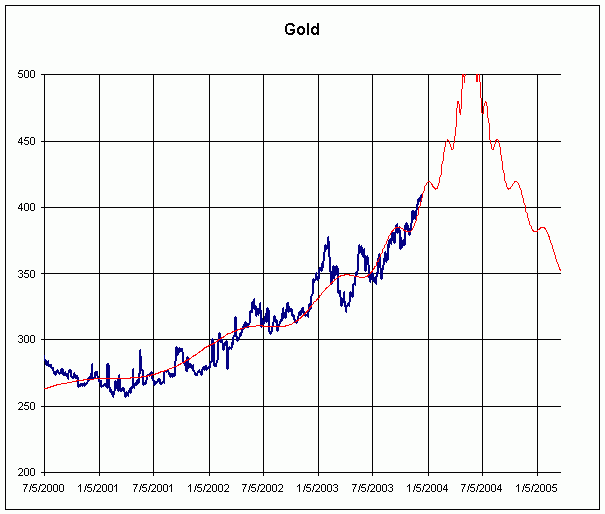
See also my earlier analysis of the crash in Gold last February. Currently, after the correction, Gold resumed a healthy bull trend showing exponential growth.
Oct 24. Here is an example of large anti-bubble cycles but very slight downward trend. My calculations show $RUT (Russel 2000 Small Cap) had its critical time, tc on Aug 22, 2000. And now $RUT is topping out in its cycle.
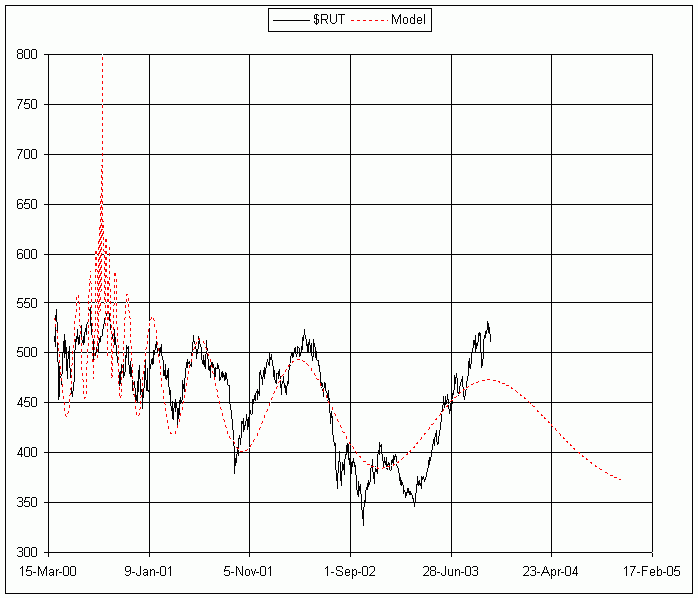
Sept 29. An example of LPPL in a stock. NEW YORK (CBS.MW) -- Energy Conversion Devices (ENER: news, chart, profile) fell almost 16 percent to $12.70 after the company delayed the filing of its Form 10-K for 15 calendar days to evaluate its accounting for an acquisition in May and warned of a stiff year-over-year drop-off in revenue for fiscal 2003 due to weak equipment sales to Rare Earth Ovonic in China and reduced funding from ChevronTexaco. Now it might appear that this stock was set for a crash anyway, based on LPPL fitting.
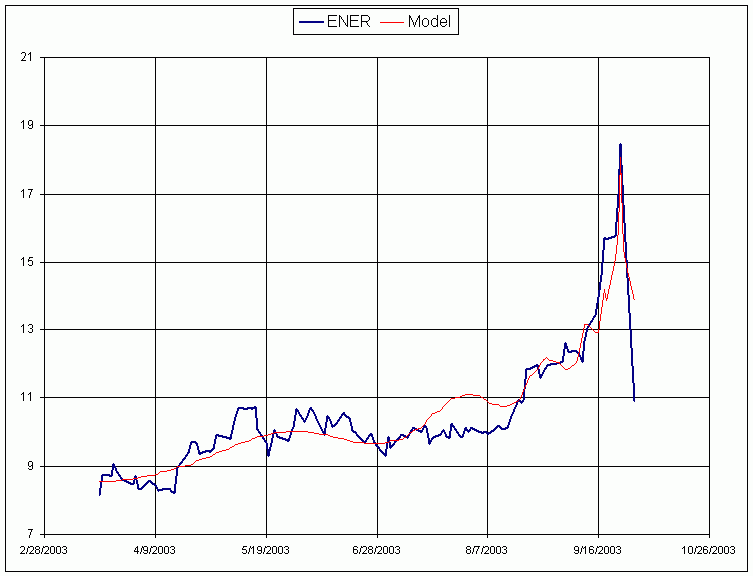
For comparison, here is the hourly chart showing the top. Note the nice smooth cycle with ever shorter waves approaching the top.
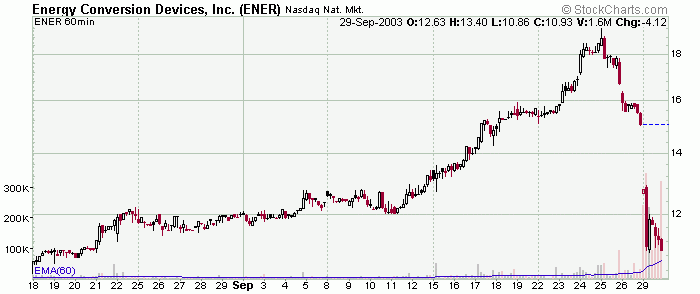
July 6. Look, it spins both ways! my observations on unemployment coverage. See also USA's new money-saving export: White-collar jobs.
SARS
There was some discussion on Clearstation boards about SARS and epidemiology. On July 11, WHO stopped issuing daily cummulative data. Read my simple epidemiology analysis of the final SARS data. Updated August 15, 2003.
Exponential growth in price and volume
Here is a 50 year chart of the SP500 including volume. Data from Yahoo, plotted using Excel.

A look at long term market indicators (60 vs. 160 week moving averages) shows the bear market continues. Got the idea listening to A Technical Perspective of the Markets & Gold with Jim Puplava and the four wise men: Richard Russell, Kennedy Gammage, Peter Eliades, Tim Wood.
Remember Enron? They will tell you to sell when it is too late. Chart from 2001.
